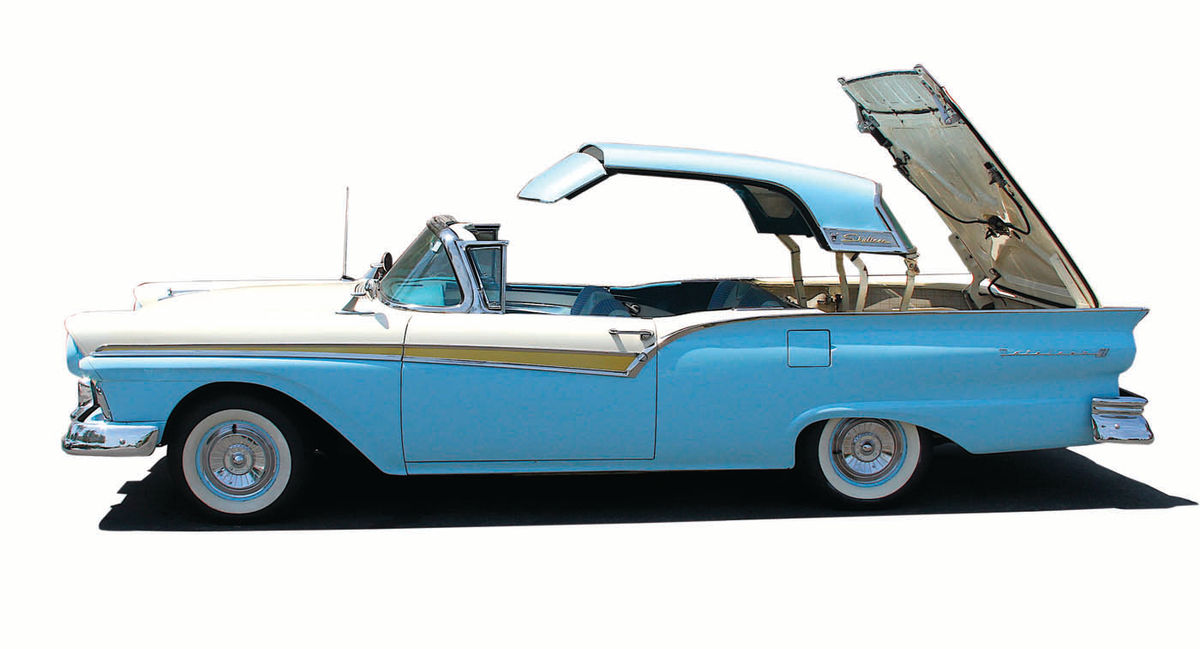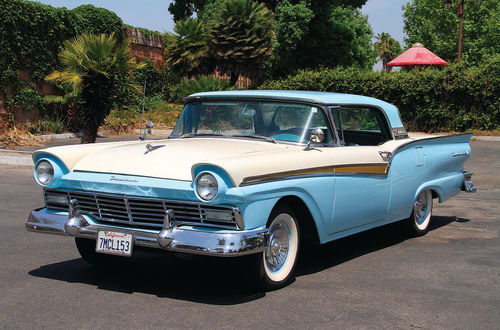1957 Ford Fairlane 500 Skyliner
Which Car Do I Want to Drive Today, the Hardtop or the Convertible? Ford’s Skyliner Gives You a Choice.
When we arrive at Chuck Hanoe’s Coast Corvette shop in Anaheim, California, our 1957 Ford Fairlane 500 Skyliner with its revolutionary “HideAway” top is waiting for us on the tarmac out front, ready for our drive report. It is the perfect day for such a car, with plenty of sunshine and moderate temperatures.
You may not have heard Ford’s novel retractable hardtop convertible described as having a “Hide-Away” top, but that is what Lucille Ball and Desi Arnaz called it in a television commercial they did at the time. Lucy gushed over the car as Desi expressed amazement, and then she took him for a ride and extolled the car’s virtues.
Entering the Hide-Away
Anxious to experience a flip top in action, I open the wide door and climb in. The dogleg “A” pillar sweeps back at an angle around the windshield that might make for a slight obstacle to a big individual’s ingress, but it’s nothing I can’t easily overcome. The instrument panel is handsome, simple and functional. Under a sweeping eyebrow echoing the car’s headlight treatment there is a foot-wide easy-to-read speedometer flanked by a fuel gauge on the left and temperature gauge on the right. Oil pressure and ammeter functions are monitored by idiot lights integrated into the speedometer.
The toggle switch to actuate the convertible top is an add-on under the dash to the left of the steering column that looks like an afterthought.
I pull the car into neutral as required and twist the key which is also on the left per Ford practice in the ’50s, and the car’s 292 V-8 comes to life. There is the faint mellow burble of the dual exhaust system, while the engine settles to a smooth idle.
Time Behind the Wheel
I pull the car into drive, which on a Ford-O-Matic transmission is second gear, and we are away. The car accelerates nicely and shifts smoothly into high at the appropriate rpm. Also included in the transmission is a low gear that can be used for quicker getaways or more often for steep hills or pulling away when hauling a trailer; however, you are required to shift in and out of it manually.
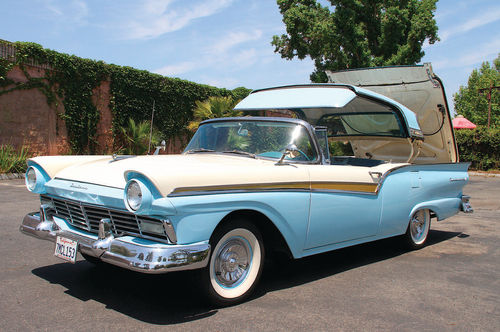
The big 118” wheelbase seventeenfoot-long Skyliner handles well in the corners, with moderate body lean, and acceleration is more than adequate. All together, it handled like any conventional 1957 Fairlane. The power brakes are not as effective as I would like, though, because the car takes a bit longer to stop than I expect. This may be due to contamination on the linings, or bonded brake shoes with modern material that is too hard. Original asbestos linings would no doubt have helped matters.
Time to Drop the Top… and Gather a Crowd
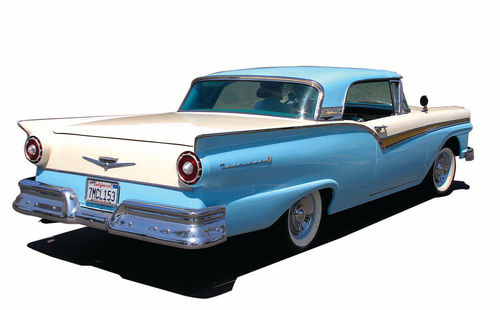
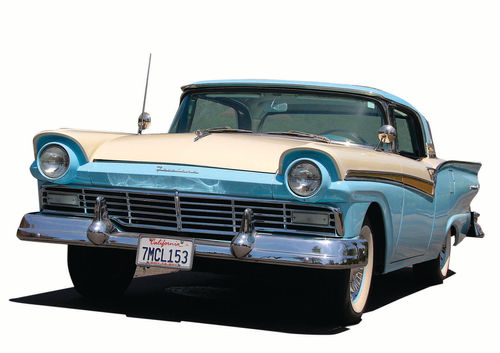
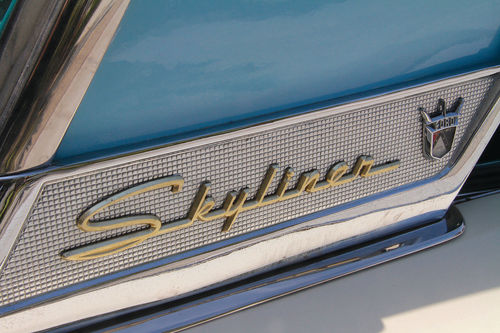
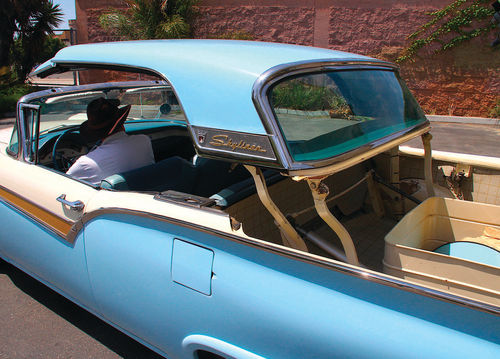
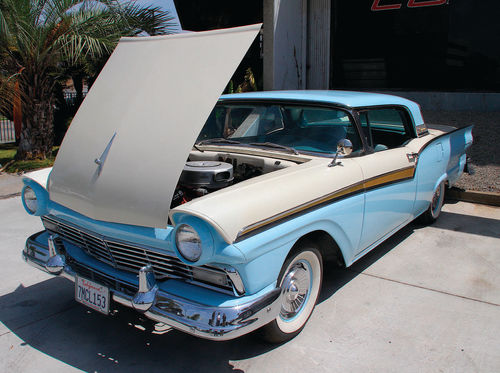
Our Hide-Away Ford gets a lot of looks and thumbs up salutes as we roll by, and a group of passersby gather when we stop and put the top down. I flip and hold the toggle switch and a fair amount of whirring, thumping and clunking ensues…but nothing moves.
Just about the time I think something might be wrong, the top comes up slowly and smoothly, and the front tip of it folds slowly under. At the same time the trunk lid pops loose at its front and folds up and back to accommodate the top. There is more whirring and thumping as the top nestles into the trunk, and then the trunk lid folds flat. Viola! We are in an open top car with no suggestion of a canvas top flopping behind us.
A Teenager’s Embarrassing Moment
It takes seven reversible electric motors, several relays, 10 limit switches, 10 solenoids, four screw lift jacks, not to mention four locking mechanisms and 610 feet of wiring to operate the top. But the whole thing works smoothly, and it only takes two or three minutes to complete its task. Also, from reports of the era, the mechanism is reliable, contrary to what many supposed at the time.
They weren’t one hundred percent reliable though, because back in 1960 I worked in a service station as a pump jockey, and a couple of girls drove in with the top and trunk lid stuck up in the air at half open and asked me and a co-worker if we knew anything about those tops. I was 18 at the time and very anxious to help them. So we did try jiggling the switch and looking things over, but then admitted that we knew nothing about them. At that the girls rolled their eyes simultaneously and drove off down the street…with the top and trunk lid resembling two metallic sails.
Ford’s Expensive and Complex Decision
As unconventional as the flip top Ford was, it sold well, with sales of 20,766 that first year, even though it cost $437 more than the conventional cloth top Sunliner. It’s all the more surprising when you consider that it was Ford’s costliest family car, with a base price of $2942. But then the conventional cloth top Sunliner sold many times that number.
The new top mechanism cost Ford over $20 million to engineer, and was originally intended for the Continental of the period. But the business end of the company pointed out that they would never recoup their investment if it were installed on the Continentals. It was then they decided to offer it on the Fords instead.
When the flip top debuted, a separate production line was set up for the Skyliner so workers could concentrate on the delicate alignment and adjustment processes required by the retractable top. Most of the retractables needed some post-assembly adjusting, but their reliability record in service was better than expected.
Unusually detailed service manuals were prepared for dealer service departments because an engine tune-up, for example, was far less-complicated than troubleshooting all those switches, relays, motors, gearboxes and cable drives.

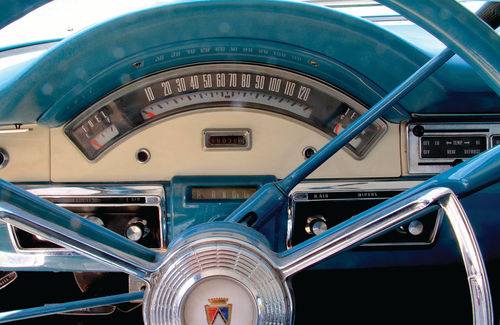
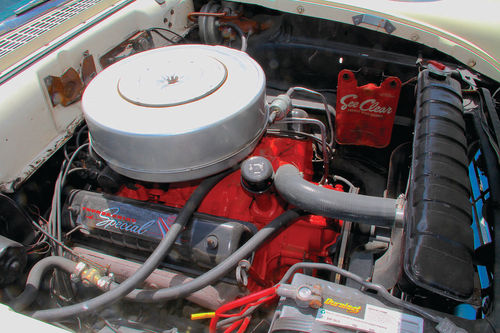
The Top All But Fills the Trunk
The hardtop convertible was first offered in 1957 and was continued through ’59. There were a few disadvantages to the innovative retractable though. For example, with the top down you only had room for an overnight case or two in the trunk because of the complex top and its folding mechanism. However, with the top up, you actually had more luggage space than a conventional car. I suppose that was not too much of an inconvenience when you consider that you weren’t likely to want the top down on long trips anyway.
I made the mistake of driving a convertible 500 miles with the top down in one day in order to get it home for a restoration years ago, and I can tell you that doing so is not recommended. I was sunburned, blistered, chapped and miserable for days afterwards. A leisurely drive around town or through beautiful countryside is great in an open car, but a long trip at highway speeds can become downright painful even when wearing a big floppy hat and slathered with half a bottle of sunblock.
There’s Discomfort In the Back…and Don’t Get a Flat
Another vicissitude with the metal drop top Fords was the fact that the back seat forced you almost bolt upright, and the passenger compartment was moved forward three inches to accommodate the top mechanism, making leg room tight. That’s because most of the electronic components that orchestrated the movement of the top and trunk lid were located on the metal panel behind the back seat.
Perhaps a worse negative with the Skyliner was the situation one encountered in the event of a flat tire. In order to get to the spare you had to lift out the luggage box to gain access to the wooden panel covering the spare tire compartment. And if the top was down when the flat occurred, you had to put it back up even to access the luggage box. And if there was anything in the box, that had to be hefted out over the top mechanism and unloaded as well.
It Truly Was Lower
Stylistically, the ‘57 Fairlane was a high water mark for Ford. It was lower, and longer, if you bought one of the deluxe 118-inch wheelbase models, and it was altogether exiting to behold, with its jet fighter exhaust taillights, swept back styling and canted fins.
To achieve this fresh new look, Ford’s new “cow belly” frame was engineered to make the low profile styling possible. This new platform permitted a lower rear floor pan. As a result, the side rails arched up higher than the 1955-56 chassis in the rear. This arrangement allowed for a twoinch drop in overall height with no loss of interior space.
The complex drop top mechanism along with the lower chassis made it necessary for the differential pinion gear to be exceptionally low in relation to the axles than other hypoid differentials. But the effect was a big improvement in the overall look of the car, making it appear longer, lower, and sleeker. Handling improved with the low profile as well.
The 1957 Chevrolet was in the third year of its shoebox body design, and was really just a gussied up ’56; but the ’57 Ford was all new, and a major departure from the earlier models. Ford had developed the technique of stamping sheet metal to allow sharper folds and creases, and this allowed for the sculpted lines in the fenders and the decorative folds in the body. At first the process resulted in a lot of panel rejection, but by 1958 the company had mastered the technique.
Ford also offered a large array of engines that year, including the 223-cubicinch economy six, the 272 base model V-8 making 190 horsepower, and the bigger 292-cubic-inch Thunderbird engine making 212 horsepower. In addition, Ford offered a 312-cubic-inch Thunderbird Special pumping out 270 to 285 horsepower depending on how it was equipped.
The 270-horsepower version used the same cam profile as the other V-8s but had added vibration dampers on the valve springs. The 285-horsepower engine came with a racing cam and supposedly was only available for NASCAR. Also, to compete with the new Chevrolet fuel-injected smallblock V8s Ford offered a McCulloch supercharger.
An Answer to Chevy’s Tough Competition
Chevrolet’s small-block 265 engine had been upstaging other makes in the stock car races for two years and in 1956 Ford CEO Robert McNamara realized that to maintain a competitive edge, Ford needed to do something in a hurry.
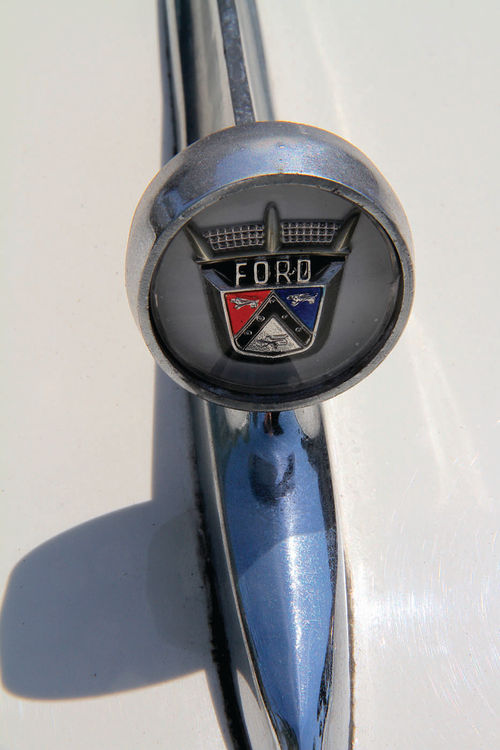

In a letter dated November 26, 1956, McNamara said, “Because a performance program is deemed essential to the maintenance of a Ford car and Thunderbird performance reputation, plans were formulated for its continuation. As you know, two high-performance engines (a 312 cubic inch 8V carburetor engine developing 270 horsepower,and 285 horsepower with a special camshaft) were approved for installation in the Ford car and Thunderbird.”
But even this was not enough to ensure victory on the track, and time was of the essence, so the abovementioned McCulloch supercharger was added to the 1957 lineup for racing that boosted the horsepower to 300. The necessary 100 production cars were completed in just two months with that number being a requirement to compete in the NASCAR Daytona Speed Trials in early February. McNamara knew that without being breathed upon, even their 312 would not be a match for Chevrolet’s new 283-cubic-inch small blocks equipped with the company’s new Rochester fuel injection.
Some Personal Time With a Y Block
I remember the Ford Y block engines well from my gas station days. They were heavier than the Chevy engines of the time because the crankcase extended well below the main bearings, hence the “Y” block name. Chevrolet’s crankcase ended at the parting line for the main bearing caps, thus saving weight. Also, Ford stuck with traditional rocker arms and shafts, whereas Chevrolet went to stamped steel rocker arms, saving a little weight and a lot of money.
Another thing that comes to mind about the Y blocks was if you neglected the specified oil changes, the oil galleries to the rocker arms would clog up, necessitating bypass surgery to keep them lubricated. This entailed adding a tee fitting behind the oil pressure sending unit so you could run copper tubing over the top of the engine and into the valve covers to supply enough oil.
Still another odd feature of the Y block engine was their over-andunder center intake ports in the heads. This necessitated sharper turns around head bolts, limiting the engine’s breathing somewhat. It wasn’t a big enough issue to make the engines uncompetitive in the ’50s, but it did limit later development. All of that being said, Ford’s ’50s-era engines were long-lived and sturdy power plants.
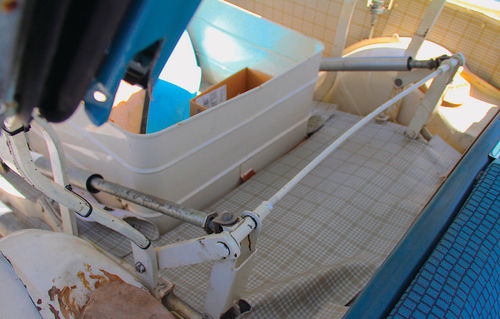

The hoods on the Fords of this era opened from the rear and hinged from the front. This was an excellent safety feature, though it made working on the front of the engine a bit more difficult. The flip top models also have their gas tanks amidships behind and under the back seat to make room for the top mechanism. This made the car somewhat safer in the event of a rear end crash.
One Colorful Cruiser
Ford’s cars came in an attractive array of elegant colors. Our drop top is done in a typical two-tone scheme of Starmist blue and Colonial white, with matching interior. This particular color scheme adds to the light and airy feel of the car, even with the top up. As a result you definitely have the feeling of cruising in style top up or down.
Our drop top 500 Skyliner was a dream machine in its day; perfect for cruising Scrivner’s Drive-in or Harvey’s Broiler in Southern California in the ’50s, and it is still exciting today. It would also have been great with the top down for the drive-in movies on a nice summer evening, and perfect for a run down the coast highway to Laguna Beach with your sweetheart.
I could have continued cruising all day, but I could see in the distance that traffic was starting to build up on the freeway, and we needed to get home before rush hour, so after shooting a few more driving shots and waving at passersby, we drove this fantastic Fairlane back to Chuck’s Corvette emporium and parts house and bid him farewell over a final cup of coffee.

